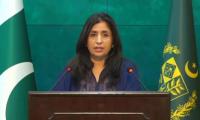ISLAMABAD: Amid PTI government’s plan to overhaul public sector companies, Ministry of Finance has silently admitted that total 197 state-owned enterprises (SOEs) have turned from profit earning to net loss making entities with whopping deficit of Rs44.77 billion in one year first time in the country’s history.
In a fresh released official SOEs Annual Report for 2015-16 comprising 306 pages, the Ministry of Finance has conceded this alarming fact that total net profit of SOEs stood at Rs193.5 billion in fiscal year 2014 that has nosedived to Rs52.934 billion in FY 2015.
However, this net profit has now turned into net loss for whole 197 SOEs and the national exchequer faced a loss of Rs44.772 billion in FY 2016. The report explained that the actual loss is largely a result of the losses booked on the balance sheet of power distribution companies (DISCOs). The profitability for DISCOs declined due to a pending court order between Ministry of Energy (Water and Power Division) and Nepra that prevented the revised actual tariff for implementation on account of prior year adjustments. With new tariff notified in March 2018, it is expected that DISCOs will recoup these losses in subsequent years, Ministry of Finance further stated.
Top ten cash bleeding SOEs have caused accumulated losses of Rs225.9 billion just in one year. The national flag carrier PIA tops among ten deficit bearing entities as it faced losses of Rs45.276 billion.
The PIA faced deficit of Rs45.276 billion, Quetta Electric Supply Company (QESCO) Rs34.608 billion, Hyderabad Electric Supply Company (HESCO) Rs27.246 billion, Pakistan Railways Rs26.994 billion, Sukkur Electric Power Company (SEPCO) Rs21.739 billion, Pakistan Steel Mills Rs18.757 billion, Peshawar Electric Supply Company (Pesco) Rs14.508 billion, Faisalabad Electric Power Company (Fesco) Rs13.311 billion, Lahore Electric Supply Company (Lesco) Rs11.184 billion and Multan Electric Power Company (Mepco) Rs10.294 billion.
Among top ten profit making companies, OGDCL clinched first position by making profit of Rs59.971 billion and National Bank of Pakistan (NBP) earned profit of Rs22.752 billion and stood at second position. The remaining profit making entities included Wapda, Parco, Government Holding Private Limited (GHPL), PPL, PSO, Gepco, NTDCL and Pak-Kuwait Investment Company.
For FY2015/16, the total number of SOEs increased from 183 in FY2014/15 to 197 in FY2015/16. The GOP established new Re-gasified Liquified Natural Gas (RLNG) terminal companies and RLNG power generation companies to facilitate installation of power plants for trading and procurement of RLNG at competitive terms.
In terms of sectoral classification, promotional and advocacy sector has most number of SOEs (46) with most of them operating as funds and foundations and research and development entities for industries and production. Energy sector comes next with 39 entities and has the biggest asset size in the entire SOEs portfolio with companies ranging from hydrocarbons to power distribution, transmission, generation and trading.
On human resources, the number of individuals employed has seen an increase by approximately 5.3% from 402,543 individuals in FY2014/15 to 424,014 in FY2015/16, largely due to new investment thrusts in the energy, transport and infrastructure sector. Sub-sectoral wise, distribution companies continue to provide employment opportunities to the most number of individuals (124,885) followed by Pakistan Railways (75,597). Consequently, the number of Board of Directors (BOD) has also increased from 970 in FY2014/15 to 1,377 FY2015/16. For FY2015/16, 27% of the total directors are Executive Directors, 47% are Non-Executive Directors while 26% are Independent Directors. Trading and energy sectors have the highest percentages of independent directors.
However, the female participation in the overall BOD needs to be strengthened as less than 5% of females are represented in the BODs. With increased investments in infrastructure and energy sectors, the total assets base of SOEs increased from Rs10.8 trillion in FY2014/15 to Rs11.5 trillion in FY2015/16. Commercial PSCs make up of 77% of the total assets base while federal authorities make up another 21%.
In terms of sectoral share, energy sector continues to top the asset base with over Rs6.7 trillion of assets in FY2015/16 followed by financial (Rs. 3.1 trillion) and transportation sectors (Rs0.8 trillion).







